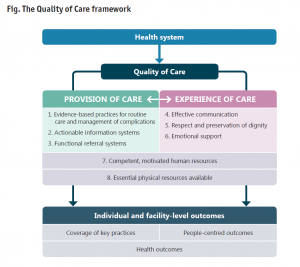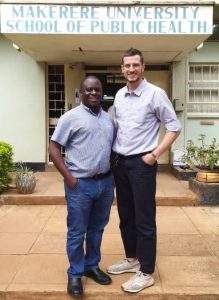

BY BEN WENDEL | In March 2020, I got the chance to work with Prof. Waiswa and Dr. Kizito on the Centre of Excellence for Maternal Newborn and Child Health’s COMONETH project. It was incepted in 2017 and is based in Eastern Uganda’s Luuka district. Luuka district is one of 112 districts located in the south eastern region of Uganda and is projected to have about 260,000 residents, according to a 2018 census. Like other districts, Luuka is struggling with a high neonatal and maternal mortality rates. COMONETH aimed to plan and implement a district wide intervention to increase healthcare capacities, improve maternal and newborn health and reduce mortality. The interventions included promotion of evidence-based practices in ante-natal and post-natal care. COMONETH also revitalized and improved access to emergency obstetric services by offering Cesarean sections and extended maternal health care at Luuka’s Level IV Health Center in Kiyunga.
Emergency obstetric services occupy an important position in maternal and neonatal healthcare and are integral to achieving COMONETH’s overarching goal of reducing maternal and neonatal mortality. Cesarean sections or C-sections are one of the most widely practiced emergency obstetric procedures and surgically deliver a baby if there are factors prohibiting vaginal birth or if complications arise intrapartum. Complications during birth are associated with a high maternal and newborn mortality. Before COMONETH a lot of mothers were not able to receive quality emergency obstetric services. Luuka is a rural district, roads are unpaved and there is no public transportation system. Before the initiation of COMONETH, emergency services were not available in Luuka and mothers regularly had to be referred to Iganga General Hospital 26km away for treatment.
I was interested to find out what mothers’ experience of care in a rural health center like the Kiyunga health center would be like. To really provide a benefit to mothers, the quality of care provided at the health center would have to be comparable to other health facilities. I wanted to investigate this question and get a deeper understanding of the maternal healthcare situation in Kiyunga. Under the supervision of Dr. Felix Kizito, I used the WHO’s Quality of care framework to write a report about the quality of care of emergency obstetric services in Kiyunga.

Using this framework developed by the World Health Organization, quality of care can be analyzed in a holistic way. It identifies several domains: health care takes place in the context of a national health system. Human and physical resources constitute the basis for care provision. Care itself can be analyzed from the provision side, where we investigated the adherence to evidence-based practices in routine care and the management of complications, the availability of a functioning referral system and an actionable information system. Experience of care occupies a prominent position in the framework and is analyzed through the indicators: communication, respect and dignity and emotional support. All these factors then contribute to individual and facility-level outcomes and can be compared to quality statements issued by the WHO.
I worked from the Demographic Surveillance Site in Iganga to draw up a concept for the report with the support of my colleagues. From there we went on field day trips to Luuka district to collect data. We planned to conduct interviews with health workers and patients at Kiyunga. I also wanted to do an exploratory analysis of patient files to reconstruct their medical history and their treatment and draw some conclusions about quality of care.
Unfortunately, I was not able to finish my work with the team due to the upcoming Corona pandemic that required me to fly back to Germany before the data collection process could be completed. Because of that I only gathered part of the data I intended to collect. The results presented here are therefore severely limited and do not constitute a representative, comprehensive investigation, but rather a subjective account.
The initiation of emergency obstetric services in Kiyunga provides a big benefit to mothers seeking care in Luuka. Services that were previously hard to access in a timely manner are now available, more accessible and provided for free to mothers. The importance of this for mothers in need of emergency treatment cannot be overstated and it constitutes a great achievement that Kiyunga is now able to deliver these services. Concern for quality of care helps to achieve good clinical outcomes for patients, but also centers around mothers’ experience of care. The mother we interviewed reported a overall good experience of care, although she had some minor complaints. This could be of special importance in a district like Luuka, where facility delivery rate is still low.
While one interview is far from enough to reach a conclusive result about mothers’ experience of care in Kiyunga, the overall good experience described by the mother proves that health workers are able to deliver good person-centered outcomes. This is very encouraging, because experience of care might directly and indirectly influence facility delivery rate. Mothers will share their experiences in their community and could influence discussions of health services in either way, depending on their experiences. The trust between the health service providers and community member, an important variable influencing facility delivery rates and other health outcome indicators, would benefit from high satisfaction with care.
On the provision side, Kiyunga routinely provides emergency obstetric services in a manner that was not possible before the initiation of COMONETH. There are still components of service delivery that present challenges, such as the quality of the information system, referral system or certain standard best-practices. Generally, Kiyunga struggles with adherence to best practice most often because it operates in a restrained health system. A lot of problems can be traced back to this higher level. Supply situations can frustrate health workers and limit their ability to provide standard treatment. While the health system is unlikely to change in the short-run, health workers prove very resourceful in dealing with the restraints placed upon them, mitigating short supplies through coordination with other facilities and ingenuity in the handling of resource limited situations. Leadership in cooperation and coordination between facilities could help alleviate some of the resource restraints and help improve the quality of care at the Kiyunga health center.

Through this internship, I got a first impression of what work in a public health research institute could look like and gave me a very meaningful perspective for my professional future. COMONETH’s approach of combining intervention and study truly stood out to me and showed me the impact that a study that is comprehensive and builds capacity in the community can have on the lives of people. I had the opportunity and got motivation to engage with the topic in maternal and newborn healthcare and get a deeper understanding of the subject than I could have gotten from any course. My special thanks goes to my colleagues, who were warm and welcoming and supported me with their advice and friendship and to Prof. Peter Waiswa, who gave me the opportunity to make this experience and guided me throughout my stay. A longer version of my experiences can be found here.
*Mr Wendel is a Medical doctor candidate Bachelor of Political Science candidate at Technical Universtiy Munich. He was in Uganda on internship.
